My Davidson | A Student Blog Embracing the Present on Davidson’s Korean Buddhist Pilgrimage
August 26, 2024
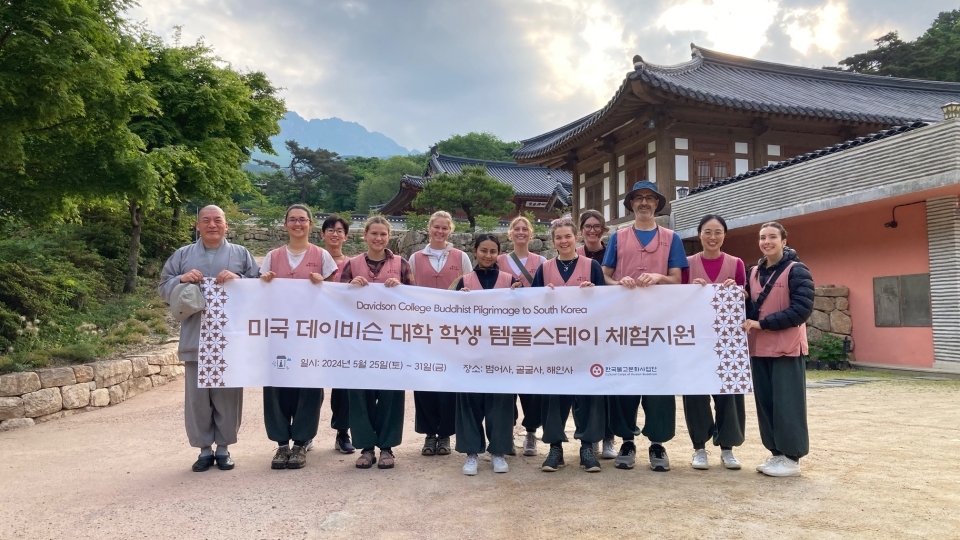
Davidson College students and faculty at the Haiensa Temple.
Davidson College students reflect on their “Korea Buddhist Pilgrimage” with Religious Studies Prof. Rachel Pang and Associate Chaplain for Buddhist Programs and Director of the Davidson Meditation Initiative, Ivan Mayerhofer.

The nine students were supported by the Cultural Corps of Korean Buddhism who discounted bus services, provided direct access to a UNESCO world heritage site and set up meetings with temple leaders. Funding was also made possible through the Chaplains’ Office Rhodes Family Endowment for Buddhist Practice and Group Investigations Funds available to Davidson College faculty.
Ivan Mayerhofer, who also serves as Davidson’s coordinator of interfaith programs, said of the trip that “the cross cultural, spiritual, and just HUMAN connections have been more than we could imagine.”
Learn more from these student participants.
Neve Rauscher '26: Embracing Early Mornings
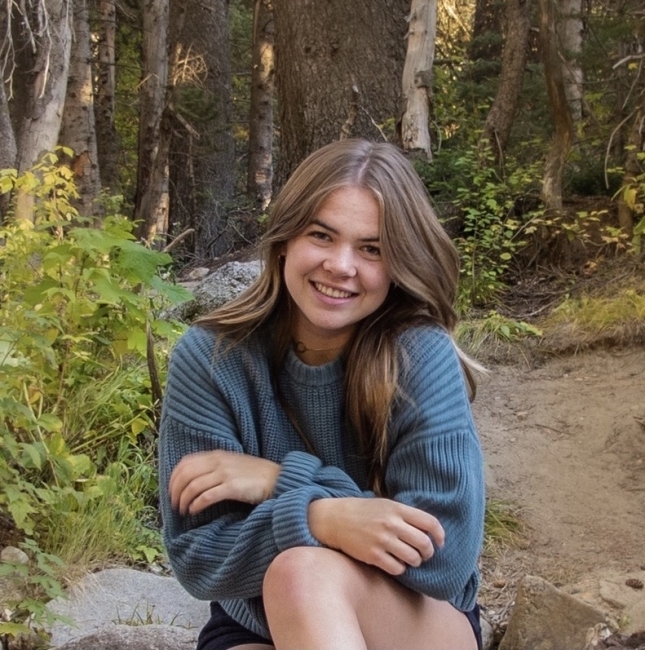
Neve Rauscher (she/her) ’26 is an Environmental Studies major from Salt Lake City, Utah.
From May 24 – June 1, 2024, eight peers, two faculty members and I explored Buddhism as a living tradition in South Korea. Our group stayed at three temples, learning about the practice from monastics and others living in the temple or working with the Jogye Order of Korean Buddhism.
On my first day with the Davidson College Buddhist Pilgrimage, our group piled into a tastefully decorated, pink-tasseled bus headed from Seoul toward Busan, South Korea. Energy and anticipation were high as we approached our final destination up a steep and curvy road—the Beomeosa Temple. Upon arrival, we didn’t even have time to stretch our legs before we were greeted warmly by the temple stay director and seunim—the Korean title for a Buddhist monk or nun. At this point, we had no idea what experiences and surprises were in store for us over the next few days, nor the close connection we would grow to feel with the monastics and the temples themselves.

A photo I snapped, following the monastics around the temple grounds at Beomeosa after morning service.
The first surprise we grew accustomed to was EARLY mornings—waking up to the sound of a hand drum at exactly 3:40 a.m.. Over the next few days, as fast as slightly jet-lagged college students could move at that hour, we pulled on our temple stay uniforms and got in parallel lines to walk in the darkness to the Beomeosa temple for morning service.
Once at the temple, we silently circled the pagoda as a group, listened to the playing of the four dharma instruments, and entered a hall to observe the morning service and perform 108 prostrations. The chanting, combined with the light beginning to spread across the temple grounds in front of us made for a morning unlike any other I have experienced.
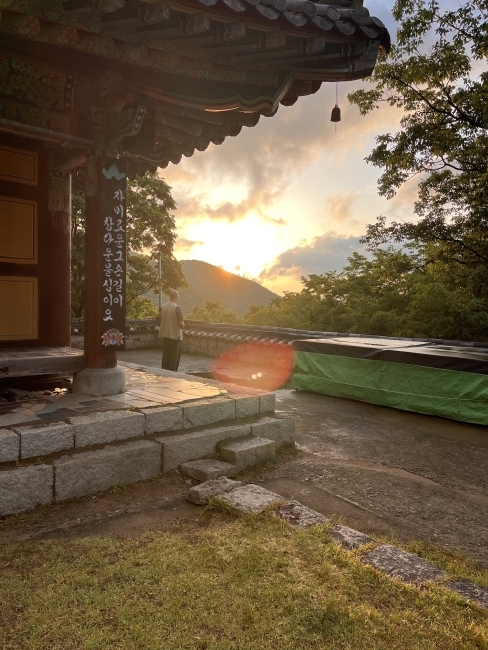
Buddhist Chaplain Ivan Mayerhofer watching the sunrise from the hermitage above Beomeosa temple.
On our third and final day at Beomeosa, we observed most of the morning service before two seunims led our group up a steep trail to watch the sunrise over the temple from a nearby hermitage. At the top, we were treated to a special traditional breakfast, a tea ceremony, and a short dharma talk with the monks. This was one of my favorite moments.
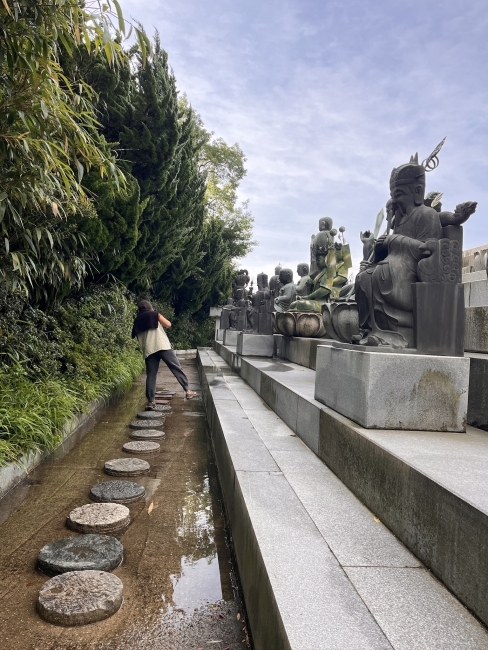
Katherine Marshall '26 balancing across a stone path while exploring a temple connected to Beomeosa.
The next temple we visited was Golgulsa Temple—a smaller, martial arts-focused temple. Morning services at Golgulsa were outdoors—beginning as the sun rose on the Buddha carved into the rock face above us. Over our few days, our group grew quite attached to Tao, the self-described ‘man of few words’ directing our temple stay. He led us in Sunmudo martial arts training on the beach and the Gyeongju Gameunsa Temple Site, asked us challenging questions over a tea ceremony, and took us on walking meditations. Our final meal at Golgulsa and goodbye to Tao were bittersweet, but our bus driver was on a tight schedule—we were expected at Haeinsa temple that afternoon!
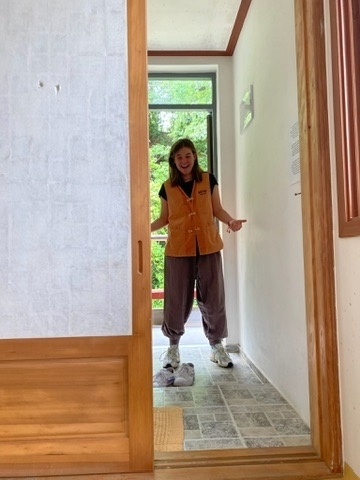
A photo of me trying on the temple uniform at Golgulsa Temple for the first time.
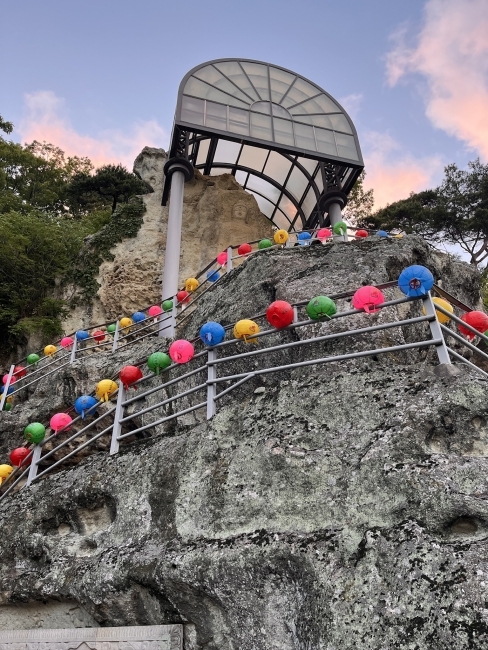
The stone Buddha at Golgulsa temple—decorated with lanterns from Buddha’s birthday celebration.

Packed in the car heading to Sunmudo training on the beach!
Over three days in Haeinsa, we jumped between tea ceremonies, meditations overlooking the valley below, morning services, and super dynamic and impressive performances of the dharma instruments. Somehow in our already packed schedule, we found time to climb lots and lots and lots of vertical feet to various sites around the temple. We could barely keep up with the seunim leading us (who was somehow only wearing slippers) as we hiked to the hermitage of the late and renowned Seongcheol Seunim. To cap off an already special stay, we were treated to an in-person viewing of the Tripitaka Koreana thanks to a surprise visit with the head monk! Our group was so excited—Dr. Pang was especially elated.
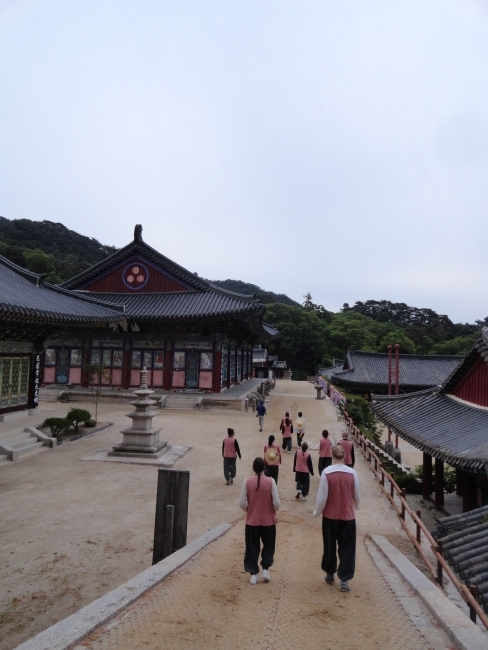
Our group heading to morning service at Haeinsa Temple.

Sydney on the steep hike up! No fear of heights here!

Our templestay seunim underneath the ancient stone Buddha. After the hike up, he answered all our questions and led us in prostrations below the carving.
We spent the last day of our pilgrimage in Seoul—experiencing the neon lights, street food, and a delightful and loud session in a karaoke room.
Though the city stood in stark contrast to the 1,000-plus-year-old wooden temples we were accustomed to, it was clear that the Buddhist practice was far from archaic. The ancient tradition is kept alive both in the city and by the monastics and others practicing in and around the temples. We witnessed how incredibly engaged the monastics were in current events, and caring for communities—both close and over 7,000 miles away, in Davidson, North Carolina!
To end, a virtual bow to Ivan Mayerhofer, Dr. Rachel Pang, the seunims who supported our temple stays, and all those who went so far out of their way to create a meaningful experience for our entire group.
Daniel Lee ’26: Sweet & Precious Morsels of Peace

Daniel Lee ’26 (he/him) is a Political Science and French and Francophone Studies double major from Ames, Iowa. On campus, he is involved with Dog-Eared Books, Men’s Club Soccer and the Deliberative Citizenship Initiative (DCI).
The Buddhist Pilgrimage sprinkled upon me such sweet and precious morsels of peace I had thought no longer possible. Removed from the constant and breathless demands of productive society, I was blessed by a comforting presence found within the fluttering warmth of those I shared life with during the temple stays. The weight of uncertainty that had plagued me for years as a physical and spiritual nomad vaporized into the blue skies, and I found delight amidst the exchange of unquestioning smiles.
Each step taken on our early morning walks up to the temple was intentional. Meditating in the presence of mother earth’s awesome creation gently awakened my senses. Savoring the clean and flavorful bites of temple food instilled a deep gratitude for nourishment. Practicing the elegant and graceful movements of sunmudo provided a greater appreciation for my own body. Greeting one another in hapjang was a physical embodiment of humility and respect towards all.
Simply put, I felt like a kid again. There was no pressure to perform; all I had to do was to be. That was more than enough. Though I was disconnected from the cranking machinery of life, I have never felt more connected to the thumping heartbeat of plainly being alive.
While I am not a practicing Buddhist, I aspire to follow the example of the monks and become a more mindful, caring soul. I hope to be a calming presence amidst the tumultuous billow of life’s whirlwind. I want to color the lives of others with a warm smile, whether at Davidson or beyond.

Crosby Boe ’25: 108 Prostrations & Measuring Success

Crosby Boe ’25 is a History and Communication Studies double major from Sun Valley, Idaho. On campus, she serves as Editor of the Davidson History Journal and on the executive board for Connor Eating House.
108 prostrations. Each prostration motivated by intention. “I prostrate to wonder where I came from, where I am, and where I am going,” “I prostrate to know that happiness does not come from others, it comes from me,” “I prostrate to be diligent in my efforts to improve myself.”
As Davidson students, we live our lives with intention—we would not be filling our days with lessons and hard work if that wasn’t the case. However, these intentions typically stem from broad-scale goals. The intent to succeed often consumes the Davidson student mind. Every student defines success differently, and too often, these intentions are too broad and too externally influenced.
“I prostrate to find my true self.” The Korean Seunim lives a daily life guided by small intentions. There is no one broad intention, but instead, small intentions that will eventually equate to larger results of tranquility, clarity of mind, and contentment; qualities that a Seunim may define as “success.”
So, what if Davidson students did better at measuring “success” by the process than the result? What if succeeding at Davidson was not graduating with a 4.0, but rather to have learned, flourished and become inspired over the four-year process?
These questions and a new focus on “the process” became overwhelmingly apparent to me on the Buddhist Pilgrimage to South Korea. Awareness, presence and kindness, moreover, intentionality, consumed the daily lives of the Korean Seunims. While living among the Seunims, the value within each moment of our lives was brought to fruition. The power of silent leadership was evident. When receiving a Dharma talk over hot tea, the Sunim stated that Buddhism, unlike other religions or approaches to life that aim to make corrections to the world, aims to make changes to one’s inner self. Everything relates to the self, the outer world is not to blame as it is out of our control. This immense attention toward the self is ever present within the Seunim. Whereas our American society may associate direct focus on the self as egocentric, the Seunims’ attention toward the self is directly opposite. Extreme awareness of one’s place within each daily moment brings intentionality to every encounter and step taken throughout the day.
For example, the same Seunim advised when approaching angry people, or those who present negativity, to not be burdened by their energy. The only thing you can control is your reaction to it. Approach anger with compassion. Approaching both controllable and uncontrollable situations with intention behind your reactions is just one example of the simple daily intentions, inspired by the Seunim, that can help better guide our lives, within Davidson and beyond.
Similarly, as explained by another Seunim kindly sharing a Dharma talk with us, if you are the one feeling anger or negativity, this is a direct reflection of the state of your inner self. The way you perceive others and the external world is simply a reflection of yourself. If you are angry, you will see others more negatively. If you are happy, you will view others more positively. People who possess anger within themselves often act angry and unsatisfied with the surrounding world. Look within yourself before blaming others. If others are at blame, your reaction is all that you can control. Deep awareness such as this helps guide Korean Seunims to live each moment intentionally. The process of experiencing, learning and growing leads to deep wisdom.
The lessons learned from the Seunims are lessons that will forever guide my life and learning. When asking the head Seunim of Haeinsa temple, ‘as students with a lot of life to live ahead of us, what is your wisdom for living our lives,’ his response further confirmed the importance of the process.
“People always tell you, do what you want to do, but what you want to do changes frequently. What you ‘want’ is only as big as what you know exists. Every day we are learning and changing, therefore what we want will always adapt.” The never-ending question of figuring out what you want to do in life circulates through the average Davidson student mind daily, largely taking away from the present moment. The present moment will guide students to deeper understandings of what they ‘want’, and appreciating the process will result in ‘success.’ “I prostrate to find freedom through wisdom.”
Sydney Ballard ’25: Fleeting Moments, Lasting Impressions

Sydney Ballard (she/her) ’25 is a Biology major with a Public Health minor from Greensboro, North Carolina/ Tappahannock, Virginia. On campus, she is involved with SK8S, Warner Hall, STEM Enrichment and Club Soccer.
As our pilgrimage drew to a close and I began to reflect on its significance, the theme of impermanence resonated deeply with me. Our journey together was filled with moments I wished could last forever—quiet acts of kindness, triumphant views after grueling hikes, and endless laughter with new and old friends. The sadness of saying goodbye to the people and places that shaped these experiences was palpable. However, shared reflections about the beauty of this impermanence offered comfort. One day, at the end of our final hike, I had expressed how painful it felt to recognize our journey was about to end. Ivan Mayerhofer, the Associate Chaplain for Buddhist Programs and mentor on the trip, offered his own insight about how he feels when a journey is coming to a supposed “end.” He acknowledged that it is indeed challenging to accept the fleeting nature of joyous moments. However, he offered that these experiences often transcend the moment to become a part of who we are, continuing to shape us in enduring ways.
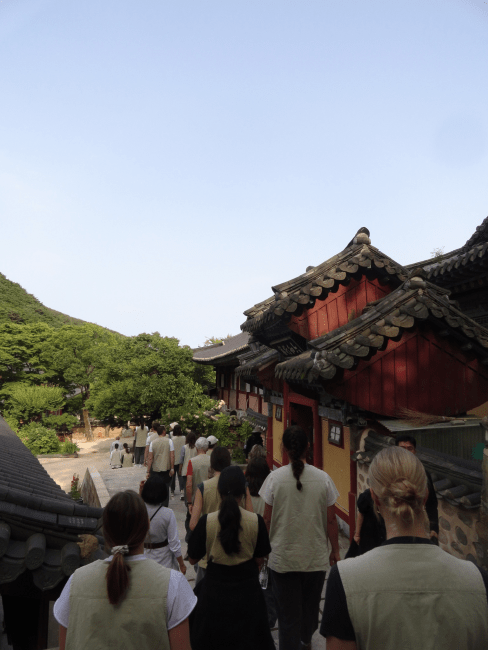
This deep-seated Buddhist belief in the interconnectedness of all things, presented itself in cyclical patterns woven throughout each of our temple visits. Although each temple offered its own unique experiences and memories, circular themes were present throughout. From the deliberate beginnings and endings of meditation sessions, where intention framed our practice, to the rhythmic cycles of prostrations, each element underscored a theme of continuity and renewal. The variety of conversations we had with Dharma teachers followed a similar pattern—beginning with initial introductions, delving into deeper meanings, and concluding with reflections on their impact. This sharing of perspectives underscored the profound power of human connection, which I have continued to consider in conversations since. Just as all things are interconnected, our daily words and actions are parts of an ongoing cycle shaping our lives and leaving an impact on the world.
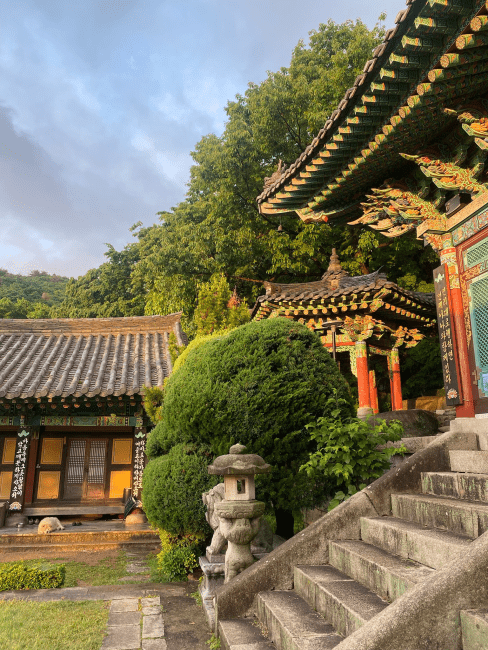

As I enter my final chapter at Davidson, I feel the pages fluttering rapidly, as expectations of life post graduation approach. Simultaneously, I am grounded by the reminder of the ways in which the temples offered a respite from this urgency. During the pilgrimage, the passage of time was not defined by what we had accomplished each day. The passage of time was felt by appreciating each sunrise and each sunset with our shared community. The most valuable aspect of our day was not our productivity but rather each encounter, filled with mutual care. Now, as we have each returned to the “normal,” in obvious ways, the cycle that shaped our incredible adventures has seemingly ended. Yet, we continue to carry the memories and lessons gained from the trip, prompting the question if there really is such a definitive thing as a beginning or an end.
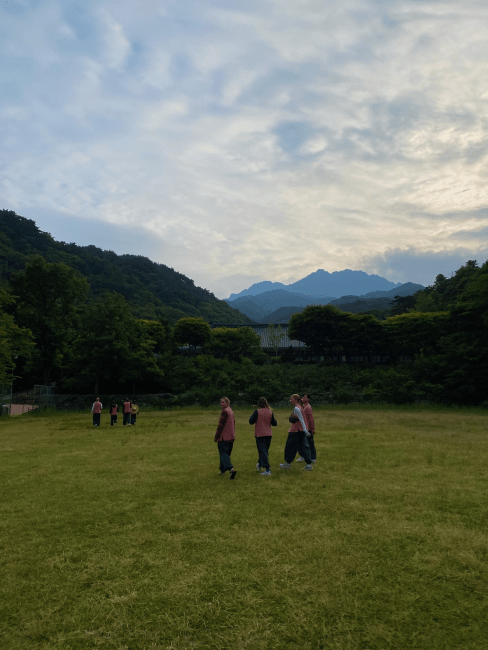
I feel deeply grateful for the wisdom and kindness shared by everyone along this journey. These experiences, evolving as they may, enrich our lives in ways that go beyond traditional academic settings. The beauty of impermanence lies in its ability to remind us of the transient nature of life and the enduring connections we forge along the way, as students and beyond.



